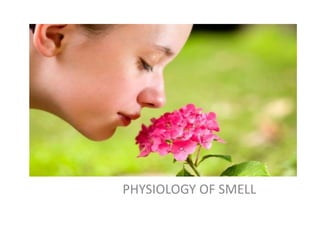
olfactory.pptx
- 2. BY GROUP 5 Name ID 1. TUT WICHMACH…………………...RU2059/13 2. EYOB KASEYA…………………………RU0037/13 3. NEJMUDIN NURA………………….RU2317/13 4. TARIKU DEMLEW……………….…RU1304/13 5. TINSAE KASSA………………………..RU3052/13 6. GIFTY GADISA…………………………RU0322/12
- 3. OUT LINE • The olfactory (smell) system • Olfactory stimuli • Olfactory cortex of the Olfactory System • Olfactory receptor cells 1&2 • Mechanism of excitation of the olfactory cells • Membrane potential & action potential of olfactory cell • Transmission of olfactory signal to olfactory bulb • Olfactory glomeruli
- 4. The Olfactory (Smell) System The olfactory system is the least understood sensory system It helps us enjoy life (e.g. perfume, and food) Smell can be a powerful stimulant of human emotions. It is also a warning system alerting us to dangerous signals (e.g., gas leak, spoiled food) It helps in choosing mates in some mammals (release of pheromones) Minute quantity of an odorant in the air can elicit a smell sensation Methylmercaptan can be smelled when only 25x10-12 g is present in each ml of air. This substance is mixed with natural gas so that even a small amount of gas leak can be detected.
- 5. Olfaction – The Sense of Smell Smell is detected by olfactory chemoreceptors which are specialized endings of afferent (bipolar) neurons that convert olfactory stimuli (chemicals in gaseous state) into nerve impulses Are found in the roof of each nasal cavity
- 6. Olfaction – The Sense of Smell
- 7. What are Olfactory Stimuli? Odorants (airborne molecules) Odorants must be volatile (they give off vapors) More vapors are given off when an odorant is heated!! (warm soup smells better than cold soup) Odorants reach olfactory receptors by being inhaled: • Through the nose. • Through the mouth (vapors circulate up through throat)
- 8. Olfactory cortex of the Olfactory System A. Peripheral components: Olfactory receptors: located in the olfactory epithelium Olfactory nerve fibers: in the the olfactory nerve (CN I) B. Central components Olfactory bulb : in the brain Olfactory tract Olfactory cortex: deep in temporal lobe and base of frontal lobe (interpretation of olfactory signals)
- 9. Olfactory Receptor Cells-1 Are the receptor cells for smell sensation. There are ~ 100 million of these cells in the olfactory epithelium Convert olfactory stimuli into nerve impulses Chemicals must be dissolved in mucus for detection
- 11. Olfactory Receptor Cells-2 They are bipolar nerve cells and , unlike other primary afferent neurons, terminate directly in the telencephalon The mucosal end of the olfactory cell forms a knob 4 to 25 olfactory hairs (cilia) emerge from the knob The cilia react to odors in the air, and stimulate the olfactory cells (causing depolarization), but HOW?
- 13. Mechanism of Excitation of the Olfactory Cells Diffusion of the odorant substance, into the mucus Odorant binds and activates the receptor protein, resulting in activation of G-protein complex This causes activation of adenylcyclase in the cell membrane This enzyme converts ATP intocAMP (a second messenger). This causes activation of sodiumion channels resulting in Depolarization and excitation of the olfactory neuron Transmission of nerve impulses into CNS by the olfactory nerve.
- 14. Mechanism of Excitation of the Olfactory Cells
- 15. Membrane Potential & Action Potential of Olfactory Cells The resting membrane potential of olfactory cells is ~ –55 mV. At this potential, most of the olfactory cells generate continuous nerve impulses/action potentials (APs) at a very slow rate (0.05 to 3 Hz). Most odorants cause depolarization and an increase in the rate of APs up to 30 Hz Like other sensory receptors, the rate of olfactory nerve impulses is dependent on of the stimulus strength.
- 16. Transmission of Olfactory Signal to Olfactory Bulb Axons of the receptor cells penetrate the cribriform plate and form the olfactory nerve (CN I) They synapse on Mitral cells in the olfactory bulb which is just superior to the cribriform plate Axons of Mitral cells travel along the olfactory tract to reach the olfactory cortex and the limbic system
- 17. Transmission of Olfactory Signal to Olfactory Bulb
- 18. Olfactory Glomeruli Olfactory receptor neurons express one type of odor receptor Receptor neurons with the same receptor type project to the same glomerulus They synapse with dendrites of mitral cells in the glomerulus. Mitral cells project to the olfactory cortex. Granule & Periglomerular cells (inhibitory interneurons) modulate mitral cell activity.
- 19. Olfactory Cortex
- 20. Neuronal Connections of the OS-1 The olfactory tract divides into 2 pathways: 1. The medial olfactory area: • Consists of nuclei anterior to the hypothalamus • Concerned with basic behavior e.g. responses to the smell of food(salivation)
- 21. Neuronal Connections of the OS-1
- 22. Neuronal Connections of the OS-2 The olfactory tract divides into 2 pathways: 2. The lateral olfactory area: • Provide inputs to all portion of the limbic system e.g. hippocampus
- 23. Neuronal Connections of the OS-2
- 25. Reference • djouhri test and smell kandel test and smell ksumsc physiology of olfactory https:www.nih.gov KSUMSC physiology of smell
- 26. •THANK YOU